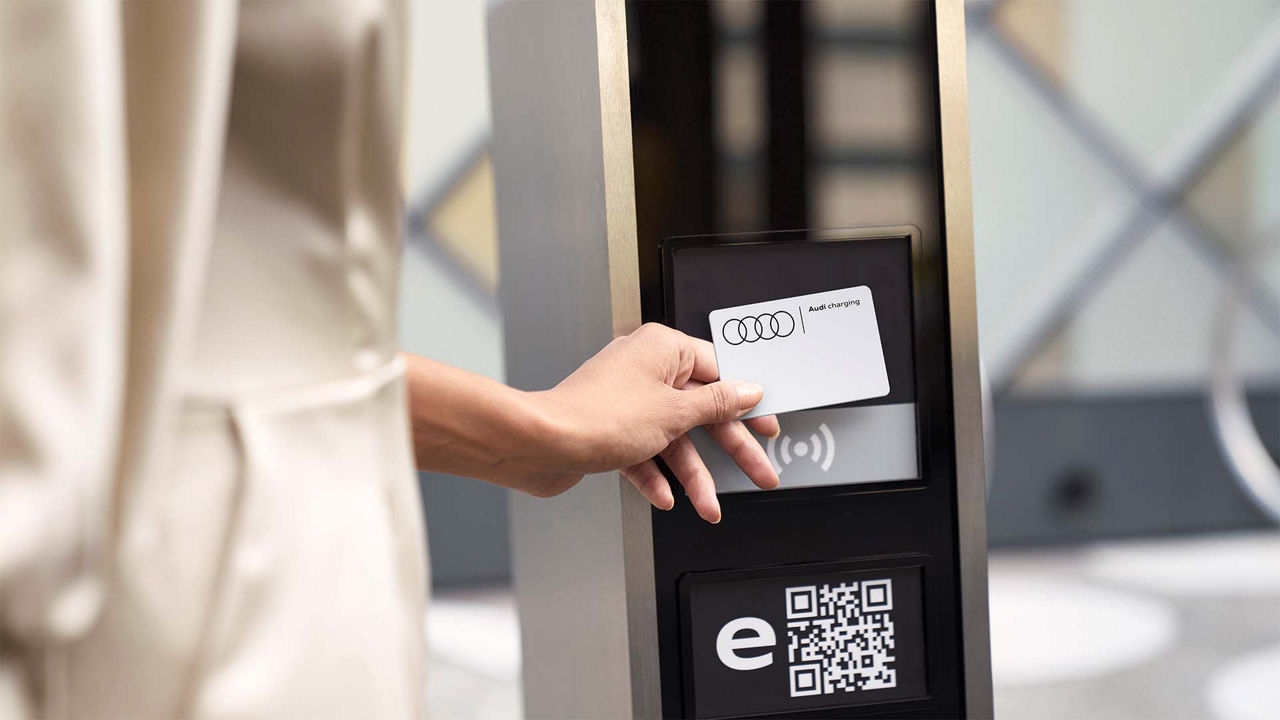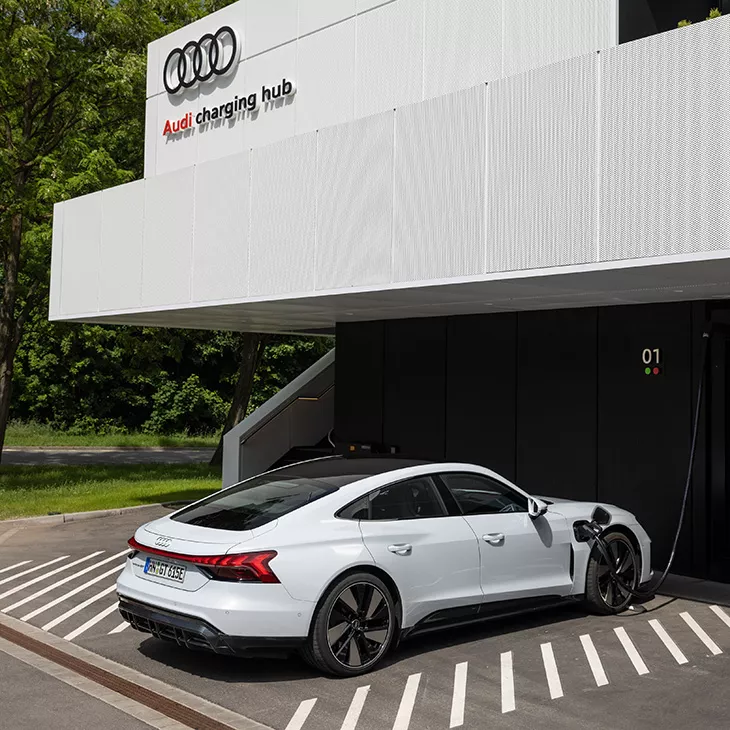1 Audi charging is an offer from Volkswagen Group Charging GmbH (Elli), Mollstrasse 1, 10178 Berlin Access and network: the number of accessible charging points is continually evolving. Audi charging can only be used for electrified models of the Audi brand (a vehicle identification number is required). Europe-wide access: Audi charging will be available in the following countries from 01/01/2023 (as per information from 01/01/2023): Austria, Belgium, Bulgaria, Croatia, Czech Republic, Denmark, Estonia, Finland, France, Germany, Greece, Hungary, Ireland, Italy, Latvia, Lithuania, Luxembourg, the Netherlands, Norway, Poland, Romania, Slovakia, Slovenia, Spain, Sweden, Switzerland and the United Kingdom. The number of charging points provided is continually being developed but is country-specific and depends on the degree of development of the available infrastructure. There is no entitlement to be able to access every charging point in a country. AUDI AG does not guarantee the operation, availability, charging performance or any other characteristics of the charging infrastructure. The location information about the number of charging points is updated regularly; no claim is made to its completeness. Authentication via myAudi App (QR code on the charging point) requires an active radio and Internet connection. Not every authentication method is available at all charging points. Prices within individual European countries are uniform but can differ from the price in Germany.
2 Last updated: 01/09/2023
3 The use of Plug & Charge requires a Plug & Charge-compatible tariff (Basic, Plus, Pro) as well as a Plug & Charge-compatible vehicle. The use of Plug & Charge is expected to be available from Q2/2023 for the following models: Audi e-tron 50 quattro (combined power consumption in kWh/100km: 23.8-21.4; combined CO₂ emissions in g/km: 0.), Audi e-tron 55 (combined power consumption in kWh/100 km: 26.1–22.2; combined CO₂ emissions in g/km: 0.), and Audi e-tron S (combined power consumption in kWh/100 km: 28.4–26.1; combined CO₂ emissions in g/km: 0.), Audi e-tron Sportback 50 quattro (combined power consumption in kWh/100 km: 25.5–21.0; combined CO₂ emissions in g/km: 0.), Audi e-tron Sportback 55 quattro (combined power consumption in kWh/100 km: 25.9–21.5; combined CO₂ emissions in g/km: 0.), Audi e-tron S Sportback (combined power consumption in kWh/100 km: 28.1–25.7; combined CO₂ emissions in g/km: 0.), Audi Q8 50 e-tron quattro (combined power consumption in kWh/100km: 24.0–20.1; combined CO₂ emissions in g/km: 0.), Audi Q8 55 e-tron quattro (combined power consumption in kWh/100km: 24.4–20.6; combined CO₂ emissions in g/km: 0.), Audi SQ8 e-tron (combined power consumption in kWh/100km: 28.0–24.6; combined CO₂ emissions in g/km: 0.), Audi SQ8 e-tron Sportback (combined power consumption in kWh/100km: 27.0–23.5; combined CO₂ emissions in g/km: 0.), Audi Q8 Sportback 50 e-tron (combined power consumption in kWh/100km: 23.7–19.5; combined CO₂ emissions in g/km: 0.), Audi Q8 Sportback 55 e-tron (combined power consumption in kWh/100km: 24.1–19.9; combined CO₂ emissions in g/km: 0.), Audi SQ8 Sportback e-tron (combined power consumption in kWh/100km: 27.0–23.5; combined CO₂ emissions in g/km: 0.), Audi Q4 35 e-tron (combined power consumption in kWh/100 km: 18.2–16.4; combined CO₂ emissions in g/km: 0), Audi Q4 40 e-tron (combined power consumption in kWh/100 km: 19.6–16.6; combined CO₂ emissions in g/km: 0), Audi Q4 45 e-tron quattro (combined power consumption in kWh/100 km: 20.2–17.1; combined CO₂ emissions in g/km: 0), Audi Q4 50 e-tron quattro (combined power consumption in kWh/100 km: 20.2–17.2; combined CO₂ emissions in g/km: 0), Audi Q4 Sportback 35 e-tron (combined power consumption in kWh/100 km: 17.8–15.9; combined CO₂ emissions in g/km: 0), Audi Q4 Sportback 40 e-tron (combined power consumption in kWh/100 km: 19.1–16.1; combined CO₂ emissions in g/km: 0), Audi Q4 Sportback 45 e-tron quattro (combined power consumption in kWh/100 km: 19.7–16.6; combined CO₂ emissions in g/km: 0), Audi Q4 Sportback 50 e-tron quattro (combined power consumption in kWh/100 km: 19.7–16.7; combined CO₂ emissions in g/km: 0) with production data as of calendar week 48/2021.Information on fuel/power consumption and CO₂ emissions where ranges are given depends on the equipment selected for the vehicle.Only consumption and emission values according to WLTP are available for the vehicles, and not those according to NEDC.Plug & Charge is available at all IONITY charging stations, among others.
4 Additional costs may be incurred depending on your mobile phone contract.
5 Customers who have taken out an Audi charging Pro tariff and who use a fully electric Audi (cash purchase, lease, financing) can be exempted from the basic fee. Their vehicle must correspond to either the current or the previous year's model year. This offer is only valid for the first contract that is taken out and cannot be transferred to others. After one year, the normal conditions for the tariff apply. This promotion from AUDI AG will be displayed to you upon concluding a contract via the myAudi app which is connected to a main user. You can take advantage of the discounted price starting 01/01/2023. Plug-in hybrid vehicles are excluded from this offer.
6 The charging rates shown and the charging card are an offer from Volkswagen Group Charging GmbH (Elli). To take out these tariffs, you will need a myAudi account and the myAudi app. The fully electric Audi model (based on the chassis number) and a main user must have been set up within the myAudi app.
7 The contract has a fixed term of 12 months and will end automatically after this period. Ordinary termination within this period is excluded.
8 All prices shown here include statutory value-added tax. Valid for Germany. Prices for other countries can be accessed via the tariff details (see tariff overview) as well as via the myAudi app.
9 The contract has a fixed term of 12 months and will end automatically after this period. Ordinary termination within this period is excluded.
10 The contract has a fixed term of 12 months and will end automatically after this period. Ordinary termination within this period is excluded.
11 To set up your vehicle in the myAudi app, you will need its chassis number.
12 Contracts can be completed starting 01/01/2023.
13 Access and network: the number of accessible charging points is continually evolving. The e-tron Charging Service can only be used for electrified models of the Audi brand (a vehicle identification number is required). Europe-wide access: the e-tron Charging Service is available in 26 European countries, and an offer for further countries is planned. The number of charging points provided is continually being developed but is country-specific and depends on the degree of development of the available infrastructure. There is no entitlement to be able to access every charging point in a country. AUDI AG does not guarantee the operation, availability, charging performance or any other characteristics of the charging infrastructure. The location information about the number of charging points is updated regularly; no claim is made to its completeness. The e-tron Charging Service customer card can only be used across the network 24 hours after card activation. The card can potentially be used within the first 24 hours with local restrictions. Authentication via myAudi App (QR code on the charging point) requires an active radio and Internet connection. This authentication method is not available at all charging points. Prices within individual European countries are uniform but can differ from the price in Germany. Current tariff and contractual information for your country can be found at www.e-tron.charging-service.audi
14 The Audi e-tron Charging Service is offered by Digital Charging Solutions GmbH (Mies-van-der-Rohe-Strasse 6, 80807 Munich, Germany).
15 The charging time of the battery may vary, depending on various factors, such as, e.g., the ambient temperature, the use of other, country-specific plugs, and the use of the preconditioning feature (e.g., remote-controlled air conditioning of the vehicle). When using household plugs, the charging power is limited by the e-tron charging system.
16 Audi e-tron GT: Combined power consumption in kWh/100km: 21.6–19.6; combined CO₂ emissions in g/km: 0. Information on fuel/power consumption and CO₂ emissions where ranges are given depends on the equipment selected for the vehicle.
17 The stated consumption and emission values were determined according to the legally prescribed measurement methods. On 1st January 2022, the WLTP test cycle completely replaced the NEDC test cycle, which means that no NEDC values are available for vehicles that have been newly type-approved after that date. The information does not refer to any, single vehicle and is not part of the offer but is used for comparison purposes only between different vehicle types. Auxiliary equipment and accessories (attachments, tyre format, etc.) can change relevant vehicle parameters, such as weight, rolling resistance and aerodynamics, and, in addition to weather and traffic conditions and individual driving behaviour, can influence the fuel consumption, power consumption, CO2 emissions and driving performance of a vehicle. Because of the more realistic test conditions, the fuel consumption and CO2 emission values measured according to the WLTP are in many cases higher than those measured according to the NEDC. This may result in corresponding changes in vehicle taxation as of 1st September 2018.Further information on the differences between WLTP and NEDC can be found at www.audi.de/wltp. Further information on the official fuel consumption and official specific CO2 emissions of new passenger cars can be found in the "Guide on fuel consumption, CO2 emissions and electricity consumption of new passenger cars" (Leitfaden über den Kraftstoffverbrauch, die CO2-Emissionen und den Stromverbrauch neuer Personenkraftwagen), which is available for free at all sales outlets and at DAT Deutsche Automobil Treuhand GmbH, Hellmuth-Hirth-Str. 1, 73760 Ostfildern, Germany, or at www.dat.de.










